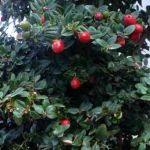| Common Name: |
Jujube |
| Other Names: |
Chinese Date |
| Botanical Name: |
Ziziphus jujuba syn. Z.vulgaris |
| Genus: |
Ziziphus |
| Family: |
Rhamnaceae |
| Native Location: |
Temperate Asia |
| Cultivation: |
Well-drained, moist to dry soil in sun. Cut back in winter to encourage the new growth on which fruits are borne. Ziziphus jujuba tolerates a wide range of growing conditions but needs a hot, dry summer to fruit well. Ziziphus species are subject to certain plant controls as a weed in parts of Australia. |
| Propagation: |
By seed sown when ripe in sandy soil; by suckers in spring; by hardwood cuttings in autumn and winter; by root cuttings in late winter at 5-10°C (41-50°F). |
| Harvest: |
Fruits are collected in early autumn when ripe, then parboiled, and sun-dried. Seeds are removed from the ripe fruits and dried. Both are used in decoctions. |
| Varieties: |
Lang
Produces large, oblong to pear-shaped, mahogany-red fruits that dry well. |
Li
Bears rounded to ovoid, brown fruits, to 5cm (2in) long, excellent when fresh. |
|
| Height: |
9m (28ft) |
| Width: |
7m (22ft) |
| Hardiness: |
Z6-10 |
| Parts Used: |
Fruits (da zao), seeds (suan zao ren) |
| Properties: |
A mucilaginous, nutritive, sedative herb, with a sweet and sour taste; it controls allergic responses, relieves coughing, soothes irritated or damaged tissues, protects the liver, prevents stress ulcer formation, and has a tonic effect on spleen and stomach energies. It also strengthens the immune system. |
| Medicinal Uses: |
Internally for chronic fatigue, loss of appetite, diarrhea, anemia, irritability, and hysteria (fruits); palpitations, insomnia, nervous exhaustion, night sweats, and excessive perspiration (seeds). Often combined with Angelica polymorpha var. sinensis (See, Chinese Angelica) or Panax ginseng (See, Ginseng), and added to tonic prescriptions as a buffer to improve synergy and minimize side effects. Long-term use reputedly improves the complexion. Fruits are also used to sweeten and flavors medicines. |
| Culinary Uses: |
Fruits are eaten fresh, semi-dried, stewed, pickled, fermented, or preserved in syrup or honey. Jujube flour is an ingredient of the fermented Korean paste, known as kochujang. |
| Bibliography: |
Encylopedia of Herbs by Deni Brown Copyright ©: 1995, 2001 Dorling Kindersley Limited pg 411
|
